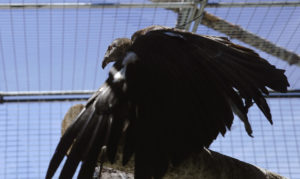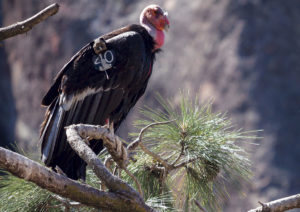For the first time in a century, condors are nesting in Pinnacles National Monument, a park of towering cliffs in the Gavilan Mountains east of Monterey Bay. The discovery is thrilling news for park biologists, who have coordinated a condor reestablishment program here since 2003.
The nest with a single egg was discovered on a popular rock climbing spot known as Resurrection Wall, on the west side of the park. Wild condors once inhabited the area around Pinnacles National Monument before the huge birds nearly went extinct due to shooting, poisoning from lead and strychnine, egg collecting, and general habitat degradation.
“These are the first signs of success in trying to bring back a wild population to the area,” said Carl Brenner, the park’s chief of interpretation and education.
All condors currently in the wild have been released as part of a captive breeding program. Both parents tending this nest were released in 2004, the mother (number 317) into the park and the father (318) along the coast at Big Sur. The birds have just reached the typical breeding age of five to six years old and are the first pair of released condors to mate in the Pinnacles National Monument. Researchers know of only one other case of a successful wild-born bird, near a ranch in south San Benito County.
Biologists will now monitor the parent condors to ensure that they are performing their natural duties of caring and feeding their young. After a childhood in captivity, the birds inevitably have a “long learning curve,” says Brenner. Because of the extremely low wild population, there are no parental examples for released condors to follow.
“We are very proud parents but are also have to stay interested in making sure they do what they need to,” said Brenner.
The areas directly surrounding the nest will be closed for protection during the nesting season, but visitors can still get a glimpse of the new condor family. A challenging two-mile trail brings hikers to the Scout Peaks bench, from which the birds can be seen clearly through binoculars or spotting scopes.
The California condor was placed on the endangered species list in 1967 but its population continued to dwindle and by the 1980s only 22 remained. Intensive captive breeding efforts began to save the bird and since the 1990s reestablishment areas have been established in northern and southern California as well as Arizona and the Baja Peninsula in Mexico.

.jpg)



